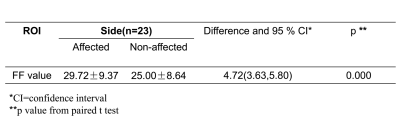1342
A preliminary study on the correlation between fat infiltration and muscle asymmetry in lumbar intervertebral disc herniation by using IDEAL-IQ1Department of Radiology, the First Affiliated Hospital, Xi'an Jiaotong University, Xi'an, China, 2MR Research China, GE Healthcare, Bei Jing, China
Synopsis
Disc herniation is one of the most common conditions of the lumbar spine.More and more people are suffering from this symptoms.Our study focused on fat infiltration of bilateral lumbar multifidus muscle in patients with lumbar disc herniation. Based on the IDEAI-IQ technology, proton density fat fraction of lumbar multifidus muscle is evaluted. The preliminary results show that the degree of fat infiltration in the lumbar spine protrusion is relatively higher in the herniated side than contralateral side.Our results can reflect the degree of fat infiltration quantitatively, which can be further expanded into the quantitative classification of different populations and different causes.
Introduction
Lumbar disc herniation is a common disease, the complications are back pain, lower limb pain and other symptoms affecting people's normal work and life. A previous study performed histopathological analysis on multifidus muscle specimens and have shown the nerve root compression by lumbosacral disc herniation causes paraspinalmuscle changes1. By measuring signal intensity on T2 weighted images, Maryse Fortin et al. concluded that there was greater fat infiltration on the side of the herniated disc and around the spine2. Iterative decomposition of water and fat with echo asymmetry and least-squares estimation intelligent quantification (IDEAL-IQ) is a three-dimensional fast gradient echo sequence that uses multiple acquired echoes to generate proton density fat fraction (PDFF) maps, and is believed to be more suitable for assessment of fat penetration in bilateral lumbar multifidus muscle. In one latest report, Zhang Y et al. evaluated the reliability of this technique on healthy volunteers. By measureing the fat content of the lumbar vertebral marrow and paraspinal muscles, the authors concluded that this technique features high reliability and is suitable for use in clinical practice3. Therefore, in this study, we aim to investigate the correlation between fat infiltration and muscle asymmetry in lumbar intervertebral disc herniation by using IDEAL-IQ technique.Methods
Results
Discussion
Conclusion
Patients with prolapse of lumbar intervertebral disc have higher degree of fat infiltration on the protruding side of the paravertebral muscle. The IDEAL-IQ technique seems to be a fast and easy approach for fat quantitative evaluation of paravertebral muscle.
Acknowledgements
No acknowledgement found.References
1.Franke J, Hesse T, Tournier C, Schuberth W, Mawrin C, LeHuec JC, et al. Morphological changes of the multifidus muscle in patients with symptomatic lumbar disc herniation. J Neurosurg Spine. 2009;11:710–4.
2.Fortin M, Lazáry À, Varga P P, et al. Paraspinal muscle asymmetry and fat infiltration in patients with symptomatic disc herniation[J]. European Spine Journal, 2016, 25(5):1452-1459.
3.Zhang Y, Zhou Z, Wang C, Cheng X, Wang L, Duanmu Y, Zhang C, Veronese N,Guglielmi G. Reliability of measuring the fat content of the lumbar vertebral marrow and paraspinal muscles using MRI mDIXON-Quant sequence. Diagn Interv Radiol. 2018 Sep;24(5):302-307.
4.O’Regan DP, Callaghan MF, Wylezinskaarridge M, et al. Liver fat content and T2*: simultaneous measurement by using breath-hold multiecho MR imaging at 3.0 T-feasibility. Radiology 2008;247:550–557.
Figures

Figure1 .a.Sag T2 FRFSE(arrow shows the disc herniated),b.Sag T1 FSE(arrow shows the disc herniated)c.Ax T2 FRFSE(arrow shows the disc herniated with left side)d.IDEAL-IQ FaFra phase ,the value of ROI is1:34.27,2:32.69

